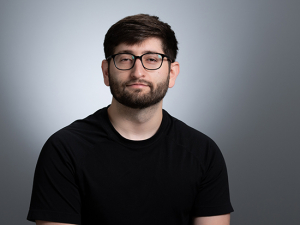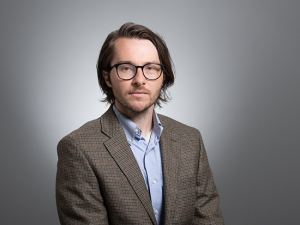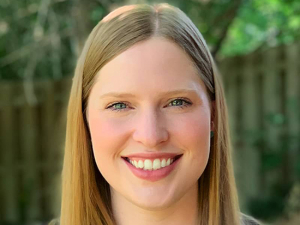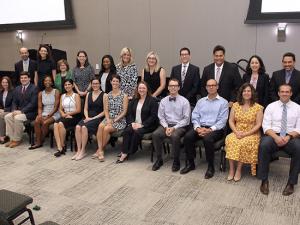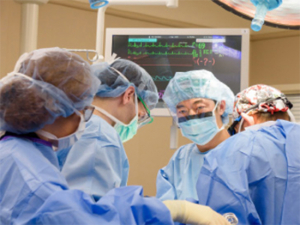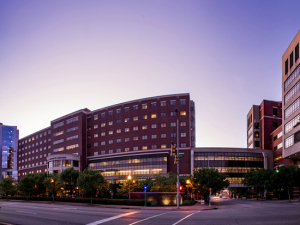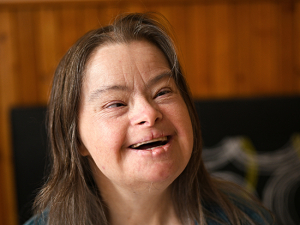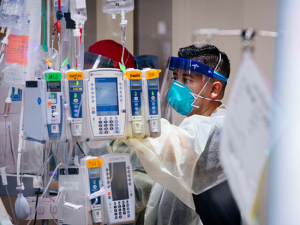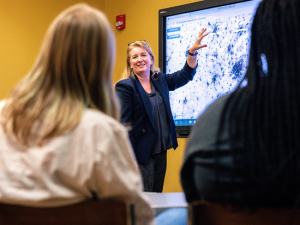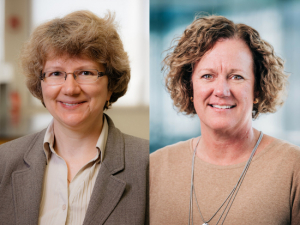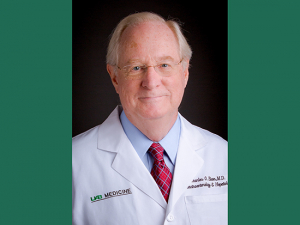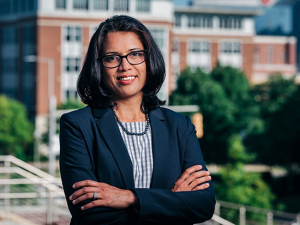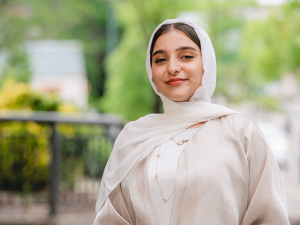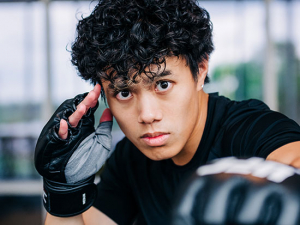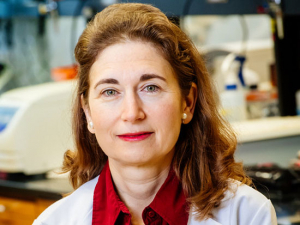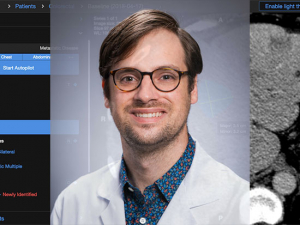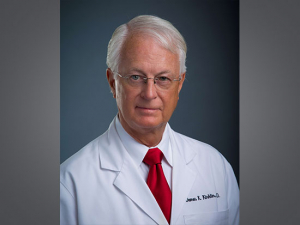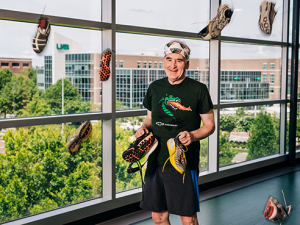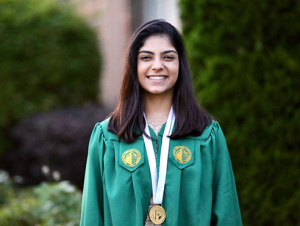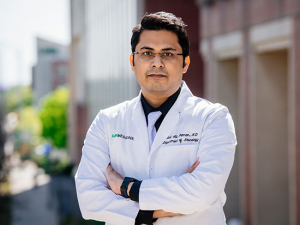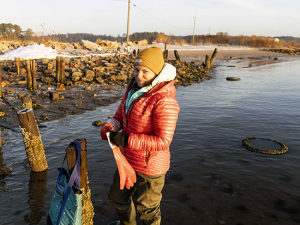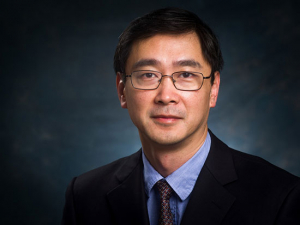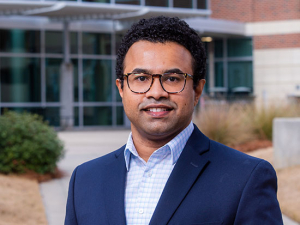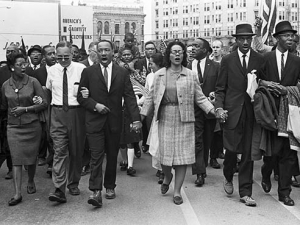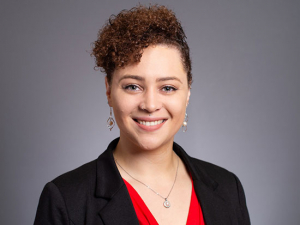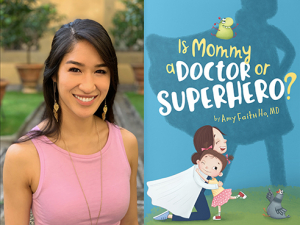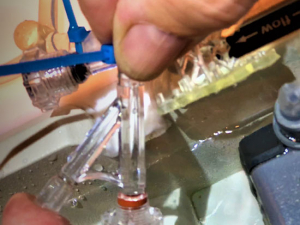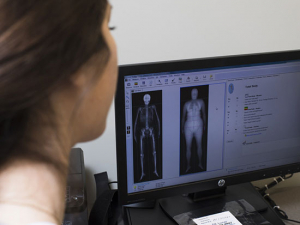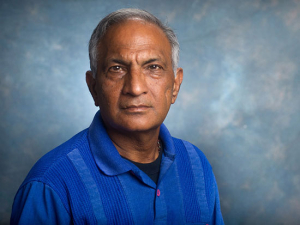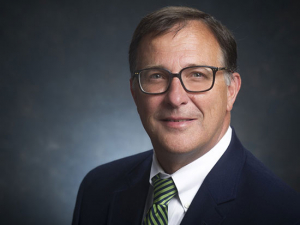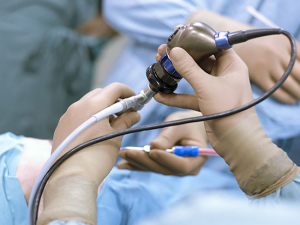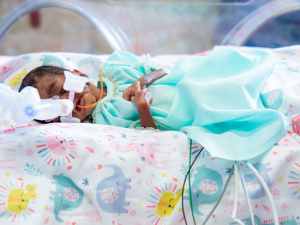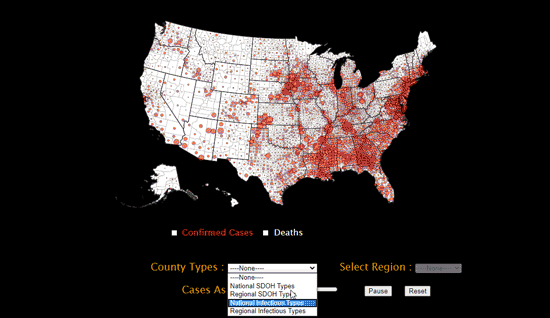 An animated example of one of the team's visualizations. The different colors on counties (purple, green, yellow, etc.) represent different clusters of factors the team has identified in its research as important. The clusters were grouped together using machine learning techniques. Then, as time advances in the animation, from early February to July, the cumulative number of confirmed COVID-19 cases for each county are overlaid on the map.The COVID-19 pandemic is the world’s first truly Big Data catastrophe, its every move tracked with global dashboards, millions of viral and human genome sequences and an expanding number of hypotheses forwarded to explain its disproportionate effect on some people and places.
An animated example of one of the team's visualizations. The different colors on counties (purple, green, yellow, etc.) represent different clusters of factors the team has identified in its research as important. The clusters were grouped together using machine learning techniques. Then, as time advances in the animation, from early February to July, the cumulative number of confirmed COVID-19 cases for each county are overlaid on the map.The COVID-19 pandemic is the world’s first truly Big Data catastrophe, its every move tracked with global dashboards, millions of viral and human genome sequences and an expanding number of hypotheses forwarded to explain its disproportionate effect on some people and places.
Making sense of this torrent calls for new approaches — procedures that help researchers uncover patterns that can guide public health action. That was the goal of an interdisciplinary team of faculty and graduate students from the UAB schools of Medicine, Public Health and Engineering and the College of Arts and Sciences. Their project, “Understanding the Impact of Social Determinants of Health on COVID-19 Outbreak,” was one of four winners of $5,000 each in the American Heart Association COVID-19 data challenge in September. The UAB team now is competing for the contest’s $15,000 grand prize, which will be awarded in November.
“The goal of the project was to study how the COVID-19 burden relates to county-level social determinants of health,” said project leader Ramaraju Rudraraju, Ph.D., assistant professor in the Department of Surgery. Social determinants of health include factors such as race, age, educational level and disability status of a community, among many others. “Understanding how COVID-19 is affecting communities with unfavorable social determinants, compared to those communities with favorable conditions, can help inform leadership from government and nonprofit agencies in prioritizing resources for testing, contract tracing and resource allocation,” Rudraraju said.
Using Census data and other publicly available data sets, the team aimed to quantify social determinants of health across the 3,000-plus counties in the continental United States and within each of the four Census regions. After doing this with multiple measures previously used in the literature, the group also added measures relevant to the differential impact of the SARS-CoV–2 virus on people with other chronic conditions, such as diabetes and heart disease. They then visualized the COVID-19 burden and the social determinants of health on an interactive national map.
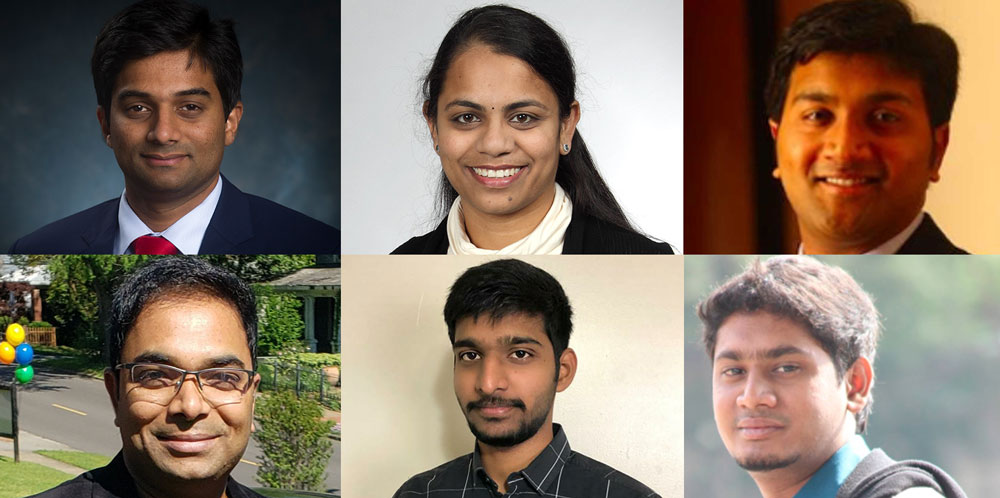 Project team members (left to right, top row) Ramaraju Rudraraju, Ph.D. (Department of Surgery); Gargya Malla, (doctoral candidate, Department of Epidemiology); Sandeep Bodduluri, Ph.D. (Division of Pulmonary, Allergy and Critical Care); (left to right, bottom row) Ravi Kumar Podapati (master's student, Department of Computer Science); Praneeth Reddy Amudala Puchakayala (master's student, Department of Computer Science); and Venkata Sthanam (doctoral student, Department of Electrical and Computer Engineering).
Project team members (left to right, top row) Ramaraju Rudraraju, Ph.D. (Department of Surgery); Gargya Malla, (doctoral candidate, Department of Epidemiology); Sandeep Bodduluri, Ph.D. (Division of Pulmonary, Allergy and Critical Care); (left to right, bottom row) Ravi Kumar Podapati (master's student, Department of Computer Science); Praneeth Reddy Amudala Puchakayala (master's student, Department of Computer Science); and Venkata Sthanam (doctoral student, Department of Electrical and Computer Engineering).
“This project needed skills from epidemiology, data processing, machine learning and data visualization,” Rudraraju said. A health informatics researcher focused on applying machine learning to health care data, he had some of the necessary skills. Gargya Malla, a doctoral candidate in epidemiology, developed the study design and analysis plan and obtained and processed the datasets from the U.S. Census and other public sources. Rudraraju, along with Venkata Sthanam, a doctoral student in computer engineering, and Sandeep Bodduluri, Ph.D., an assistant professor in the Division of Pulmonary, Allergy & Critical Care Medicine, focused on processing COVID-19 datasets from Johns Hopkins University and ran the machine-learning algorithms to perform unsupervised clustering of the counties based on the social determinants of health. Meanwhile, Ravi Kumar Podapati and Praneeth Reddy Amudala Puchakayala, both master’s students in computer science, worked on visualizing the results from the analysis and deploying those results on a website.
“Now more than ever, we need to work together to better understand why some communities are affected more than others so we can plan our responses accordingly.” |
“I really liked the idea that I could work with people who are not in public health but still move forward a public health idea,” said Malla. “Now more than ever, we need to work together to better understand why some communities are affected more than others so we can plan our responses accordingly.”
The team was able to get a head start on its work during this summer’s COVID-19 Data Science Hackathon sponsored by the UAB Informatics Institute, Center for Clinical and Translational Science and AI.Med Lab. “We explored some of our initial ideas during the UAB hackathon and got an understanding of what works better,” Rudraraju said. “We continued the work and refined the analysis for Phase I of the AHA data challenge.”
Now, “we are continuing to work on the analysis, making improvements for Phase II” of the American Heart Association’s contest, Rudraraju said. “We plan to publish our work after the submission date on Nov. 1.”
